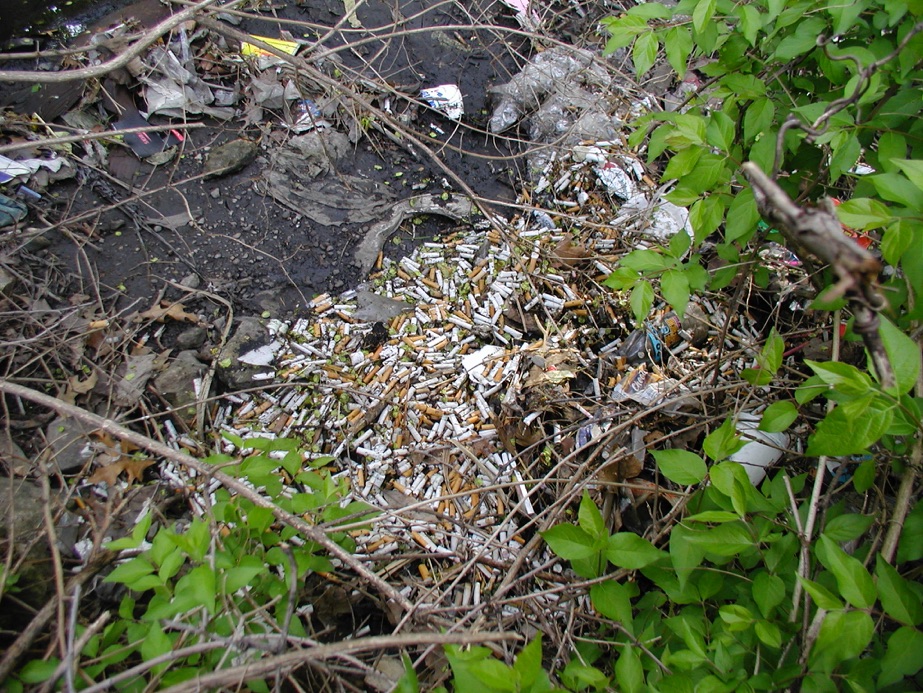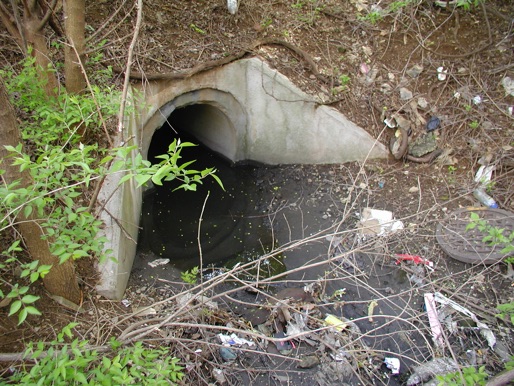Welcome to BadwaterJournal.com© INDEX PAGE for all articles
urban storm water pollution
Multi-acre parking lots, interstate highways and city and county roads contribute significant run off pollution to local streams. They contribute heavy metal particles, toxic chemicals and fecal bacteria pollution from pet and animal waste. Hard pavement does not absorb the rain fall but immediately passes it to storm drains which rapidly fill to overflowing and cause rapid increase in flow levels of receiving creeks. The rapid flows scour creek bottoms and erode stream banks filling the water with sediment that buries stream life.
As the fleet of millions of vehicles travels about Jefferson County everyday, oils drips from oil pans, brake metals grind and wear into bits, synthetic rubber tires wear into tire dust, nickel, iron, copper, anti freeze, automotive chemicals drip onto the pavement. Combustion products create a brown hue to the air we breath. This soup of pollution floats or falls to the ground and is washed into the creeks with the rain. The air is clear and sweet smelling after a rain. The creek is full of human caused pollution.
“Metal elements that are primarily particulate bound include Pb(lead), Fe(iron), Al(aluminum), and Cr (chromium). Of the predominately dissolved metal elements, Zn (zinc) Cd (cadmium), and Cu (copper) exceed surface water discharge concentration limits for the adjacent receiving waters. Metal elements that exceed surface water criteria are those that are predominately dissolved in lateral pavement sheet flow. This is a major concern because dissolved metal elements are readily bioavailable and very mobile.”
Sansalone, John J., and Buchberger, Steven G., (1997), Partitioning and First Flush of Metals in Urban Roadway Storm Water, Journal of Environmental Engineering, February 134-142.
The pattern of degradation of the water environment in Jefferson County cannot continue.
In Jefferson County, public officials have fallen all over themselves to cut up and sell the environment as fast as possible to generate GROWTH. This consecrated and holy word is sacrosanct in officialdom and is defined in this county as GROWTH = GOOD.
Jefferson County has been planned by profit seeking private corporate builders without sufficient consideration of the comprehensive, long term social and environmental effects. Cheap rural land in the eastern part of the county has fueled significant development while the urban core has been allowed to lapse into social and environmental decay. The old city of Portland and the West end are largely abandoned by new capital development that is trending east, and the predominantly African American population is ghettoed in the west end with polluting chemical plants and old industrial brown fields. See,
Urban Form and Social Justice webpage.
Louisville is very high on the list of bad air cities and is one of the worst water pollution dischargers to the Ohio River. Glossy business advertisements that put a smilely face on the challenge of increasing toxic pollution of the environment in Louisville, cripple efforts to come to grips with crafting a sustainable future.
In the coming decades the crisis of environmental pollution dictates that we cast aside the old disinformation tactics used to defeat environmental protection. Malignant, GROWTH does not equal GOOD.
Green Renewal and Green Redevelopment is the course for the next hundred years in Louisville, and we must take stock of what we have lost, and stop paying lip service to ignorant, outmoded concepts. Environmental pollution costs. Because the sewer system was allowed to serve malignant development Louisville’ MSD is under an $840 million dollar consent decree to fix it.
Beargrass Creek medallion indicates whatever drains here goes into the creek in storms.
Here is a storm water control and settling basin installed in an urban neighborhood with alternatives use as a park area. The grills lead storm water to the storm drain system.
A rain barrel catches storm water from a garage roof and stores it for reuse on the garden in dry weather. If many neighbors store and detain storm water like this, it will reduce sewer overflow pollution to our urban streams. Thank you neighbor!


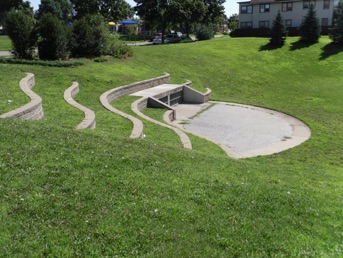


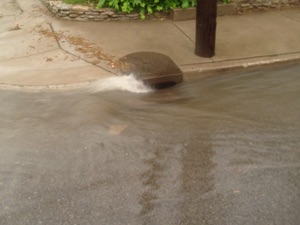
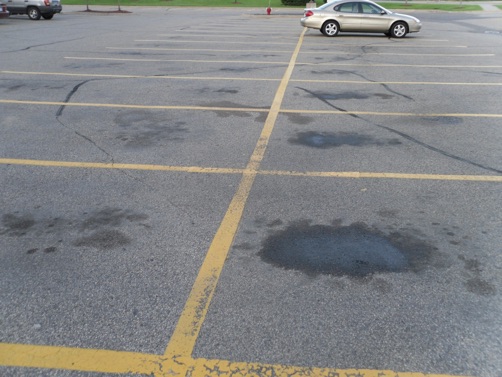
Two pictures of the same storm runoff outlet from Breckinridge Lane to Middle Fork of Beargrass Creek at DuPont Square above Cherokee Park. Parking lot runoff garbage, cigarette butts, metals, oil and hydrocarbon pollution in the summer, deicing salt and garbage in the winter.
Excerpted from:
Public Health Effects of Inadequately Managed Stormwater Runoff
Stephen J. Gaffield, PhD, Robert L. Goo, Lynn A. Richards, MSES, MPA,
and Richard J. Jackson, MD, MPH
“Urbanization of the landscape adds to strain on water resources by expanding the area covered by impervious surfaces that shed virtually all rainfall and snowmelt. Hydrologic models predict large increases in runoff for urbanizing areas, with runoff volume increasing linearly with impervious surface area. 56
Long-term stream-flow monitoring has shown that development leads to higher flood peaks 57 and to increases in annual runoff volumes of 2 to 4 times previous levels for suburban areas and 15 times previous levels for highly urban areas.58,59
Increased runoff volume generates greater [metals pollution] in urban area in a watershed near Indianapolis, Ind, between 1973 and 1991, annual average runoff volume increased by 80%, and average annual loads for lead, copper, and zinc increased by more than 50%.61
High proportions of urban land cover and steep slopes—predictors of high runoff volumes— correspond with high fecal coliform levels in South Carolina watersheds. 62
Elevated fecal coliform levels also have been detected in suburban streams.63
Although low-density development with large lawns leads to a low proportion of impervious cover within individual lots, the total impervious surface area of low-density residential and commercial developments, on the regional scale, is typically much larger than that of higher-density developments.64,65
This high proportion of impervious surface area is largely a result of roads and parking lots,
which can account for more than 60% of a low-density development’s impervious area.66
Although large lawns might seem capable of absorbing runoff from adjacent surfaces, they are typically compacted by construction equipment and can generate up to 90% as much runoff as pavement. 67,68
Runoff measured from suburban developments has been shown to be 1.5 to 4 times greater than that from rural areas, 69,70 although low-density development may produce less runoff than do some intensive agricultural land uses.71
Moreover, construction of low-density developments disturbs the soil over larger land areas, accelerating transport of sediment and associated pollutants into water bodies. Stripping the protective vegetation cover from construction sites accelerates soil erosion to a rate up to 40,000 times higher than before the soil was disturbed.72
During brief periods of active construction, sediment yield from watersheds can increase 5-fold, with additional deposition in stream channels providing a continual sediment source during subsequent storms.73 This accumulated sediment can harbor large populations of bacteria and other pathogens.74
-
1. Bhaduri B, Minner M, Tatalovich S, Harbor J., Long-term hydrologic impact of urbanization: a tale of two models. J Water Resources Plann Manage. 2001; 127:13–19.
-
1.Urbanization and Streams: Studies of Hydrologic Impacts. Washington, DC: US Environmental Protection Agency; 1997. Report EPA-841-R-97-009.
58. Spinello AG, Simmons DL. Base Flow of 10 South- Shore Streams, Long Island, New York, 1976–85, and the Effects of Urbanization on Base Flow and Flow Duration. Reston, Va: US Geological Survey; 1992. Water- Resources Investigations Report 90-4205.
59. Burges SJ, Wigmosta MS, Meena JM. Hydrological effects of land-use change in a zero-order catchment. J Hydrologic Eng. 1998;3(2):86–97.
60. Charbeneau RJ, Barrett ME. Evaluation of methods for estimating stormwater pollutant loads. Water Environ Res. 1998;70:1295–1302.
61. Bhaduri B, Harbor J, Engel B, Grove M. Assessing watershed-scale long-term hydrologic impacts of land use change using a GIS–NPS model. Environ Manage. 2000;26:643–658.
62. Smith JH, Wickham JD, Norton D, Wade TG, Jones KB. Utilization of landscape indicators to model
potential pathogen impaired waters. J Am Water Resources Assoc. 2001;37:805–814.
63. Mallin MA, Wheeler TL. Nutrient and fecal coliform discharge from coastal North Carolina golf courses. J Environ Qual. 2000;29:979–986.
64. Zielinski J. The benefits of better site design in residential subdivisions. In: Schueler TR, Holland HK, eds. The Practice of Watershed Protection. Ellicott City, Md: Center for Watershed Protection; 2000:11–24.
65. Zielinski J. The benefits of better site design in commercial development. In: Schueler TR, Holland
HK, eds. The Practice of Watershed Protection. Ellicott City, Md: Center for Watershed Protection; 2000: 25–34.
66. Impervious Surface Reduction Study: Technical and Policy Analysis: Final Report. Olympia, Wash: City of Olympia, Public Works Department; 1995.
67. Legg A, Bannerman R, Panuska J. Variation in the Relation of Rainfall to Runoff From Residential Lawns in Madison, Wisconsin, July and August, 1995. Madison, Wis: US Geological Survey; 1996. Water-Resources Investigation Report 96-4194.
68. Wignosta M, Burges S, Meena J. Modeling and Monitoring to Predict Spatial and Temporal Hydrological Characteristics in Small Catchments. Seattle: University of Washington, Dept of Civil Engineering; 1994. Water Resources Series Technical Report 137.
69. Buttle JM, Xu F. Snowmelt runoff in suburban environments (Ontario, Canada). Nordic Hydrology. 1988; 19:19–40.
70. Stephenson D. Comparison of the water balance for an undeveloped and a suburban catchment. Hydrological Sci J. 1994;39:295–307.
71. Liu AJ, Tong ST, Goodrich JA. Land use as a mitigation strategy for the water-quality impacts of global warming: a scenario analysis on two watersheds in the Ohio River Basin. Environ Eng Policy. 2000;2:65–76.
72. Harbor J. Engineering geomorphology at the cutting edge of land disturbance: erosion and sediment control on construction sites. Geomorphology. 1999; 31(1–4):247–263.
73. Roberts WP, Pierce JW. Deposition in Upper Patuxent Estuary, Maryland, 1968–1969. Estuarine
Coastal Shelf Sci. 1976;4(3):267–280.
74. Schillinger JE, Gannon JJ. Bacterial adsorption and suspended particles in urban stormwater. J Water Pollut Control Fed. 1985;57:384–389.
